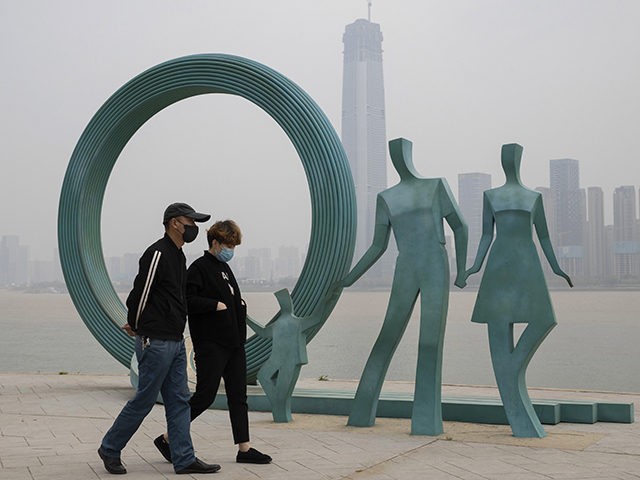Chinese state media announced on Tuesday that the city of Wuhan, epicenter of the global coronavirus pandemic, will “resume outbound transport in less than 24 hours,” formally ending a 76-day lockdown.
The Chinese government claims there are virtually no new infections and zero deaths in Wuhan, but outside observers strongly doubt either of those claims are accurate.
China’s Global Times said Wuhan will “see the resumption of normal life” on Wednesday, “even as epidemiologists warned that it is not the time to completely lower the guard and ease on full-scale restrictions.” Chinese officials claim they are now primarily worried about asymptomatic carriers of the Wuhan virus and travelers bringing it back into China from overseas.
The Chinese Communist Party (CCP) celebrated the reopening of Wuhan as a “milestone” and claimed the Wuhan lockdown “helped slow the virus’ transmission to other parts of the country and delayed the spread to other countries.” In reality, outside observers estimate the CCP caused some 95 percent of the infections and deaths around the world by concealing the virus for as long as possible, undercounting the number of illnesses and deaths it caused in China, and denying that it could be transmitted between humans at all.
The Global Times report on Wuhan reopening for business was peppered with caveats about how extreme caution was still necessary, stressing the need for strict adherence to the “health code” system that requires citizens to display color-coded QR codes transmitted to their cell phones by the authorities to demonstrate they are cleared to travel and work.
“Everywhere I go, I need to scan a QR code, then those places I visit would be on the record,” one Wuhan resident explained.
The CCP sought to lock in its count of 3,335 coronavirus fatalities by staging three minutes of silence in Wuhan on Saturday, which marked the traditional Qingming “tomb-sweeping” festival for the dead in China. The Global Times dismissed as “insane” reports in Western media about Wuhan authorities banning crowds of mourners from gathering at cemeteries because such public displays of grief would make it clear that far more than 3,335 people died from the coronavirus.
The Washington Post filed one such report on Saturday:
Adding to the angst, tomb-sweeping rituals — when huge crowds flock to cemeteries — have been either banned or severely curtailed by authorities nationwide. While a limited number of mourners with reservations will be allowed into graveyards in Beijing and Shanghai, there will be no such gatherings in Wuhan, where the municipal government has banned funeral ceremonies and tomb-sweeping until at least May.
This is ostensibly because of health issues, but it also reflects Beijing’s political desire, experts say, to deny emotional families the chance to get together and complain about the government’s handling of the outbreak — a matter of acute sensitivity for the ruling Communist Party.
While keeping a tight lid on any public display of disagreement with the official death toll, the CCP held an exuberant “victory celebration” at one of Wuhan’s field hospitals. Party operatives danced around waving Chinese Communist flags to celebrate the defeat of the virus, with no sign of mourning or contrition at all:
“Historically, the Chinese Communist Party’s propaganda agencies have always marked tragic events with celebrations of the party’s victory. As a result, families of the deceased are deprived of their right to mourn the dead,” the Epoch Times observed.
According to the Chinese government, there have been no coronavirus fatalities anywhere in China outside of Wuhan since March 31. On Monday, the government claimed there were no fatalities in Wuhan for the first time since the beginning of the outbreak.
The official CCP position is that almost all of the handful of new infections reported since late March were “imported” cases, although even if that were true, most of the “foreign” cases highlighted by state media are actually Chinese nationals returning home from other countries. Although China once vigorously opposed travel bans against its own citizens and was able to get the World Health Organization (WHO) to echo its criticism of such restrictions, it has largely banned foreigners from entering China to keep the number of “imported” infections down.
Wuhan attempted to ease some of the lockdown restrictions last month, declaring thousands of residential compounds “epidemic-free” and permitting their residents to leave home for a few hours at a time, only to revoke many of those epidemic-free designations as infections continued to appear. The official line on those new cases is that they are almost entirely asymptomatic, making them very difficult to detect even with the much-touted testing and control system imposed on Wuhan.
Wuhan also began experiencing an unsettling wave of “re-infections” in late March, as some five to ten percent of patients who tested virus-free were re-tested and came up positive. Government officials downplayed the extent of the re-infections and generally count them as “asymptomatic carriers.”

COMMENTS
Please let us know if you're having issues with commenting.